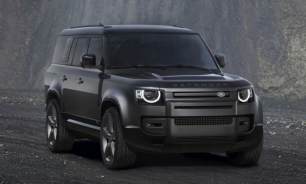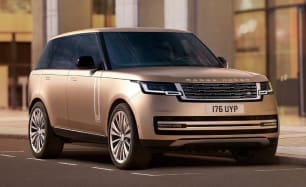What's it like to drive? It’s bloody great.
This is a big vehicle – have I mentioned that already? – but powered by this V8 the Defender 130 punches along with nary a care in the world.
Throttle response is crisp, and the 5.0-litre supercharged petrol’s 368kW and 610Nm are always readily available for a snap-punch standing-start, or to smoothly and safely overtake other vehicles on the open road.
This Defender has an official 0-100km/h sprint time of 5.7 seconds and a listed maximum speed of 240km/h!
By the way, it doesn’t hurt that the V8’s growl is piped through quad outboard mounted exhausts.
The eight-speed automatic transmission is supremely clever but the shifter’s stubby size and awkward location (under the multimedia system’s touchscreen) is annoying.
Otherwise, this V8 130 is smooth and refined, with tremendous road-holding abilities despite a Landie legacy of past-generation Defenders being about as composed as dodgy tractors.
What’s more, comfort levels are exceptional in a vehicle model once considered a form of punishment in which to travel.
Steering has a well-weighted driver-friendly feel to it and this upper large SUV never feels too cumbersome to navigate through even busy city streets, even though it has a turning circle of 12.8m.
Some body roll creeps in every now and again – especially when you become energetic throwing this giant around corners, etc – but otherwise this big bulky vehicle is well controlled and comfortable.
The air suspension negates the majority of thumps and bumps you might be expecting to get from a vehicle riding on 22-inch wheels and low-profile tyres over irregular road surfaces.
Our test vehicle was on 22-inch rims and 275/45 R22 Continental CrossContact RX “SUV performance” tyres, which are fine for driving on sealed surfaces, but if you’re looking to do any off-roading in this Defender get a set of more appropriate all-terrains.
I wasn’t driving the 130 to test its 4WDing prowess this time, but it’s still worth noting the Defender’s off-road measurements include 293mm of ground clearance (with air suspension), a wading depth of 900mm, and approach, departure and ramp-over angles of 37.5, 25.8 and 27.9 degrees, respectively.
This Defender 130 has a gross vehicle mass (GVM) of 3380kg and a gross combined mass (GCM) of 6380kg.
It has an unbraked towing capacity of 750kg, and braked towing capacity of 3000kg (with maximum 300kg on the towball), which is somewhat of a disappointment and sub-par for the upper large SUV segment.

